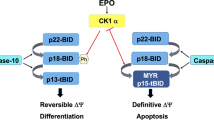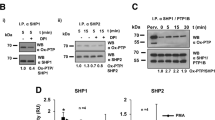Abstract
Triggering differentiation has been employed as a strategy to inhibit cell proliferation and accelerate apoptosis in malignant cells. To better understand the mechanisms underlying differentiation-mediated regulation of apoptosis, we have studied the effects of PKC pathway with an activator of the protein kinase C, 12-O-tetradecanoylphorbol-13-acetate (TPA), during hemin-induced erythroid differentiation of K562 erythroleukemia cells. K562 cell line has been used as a model of common progenitor of erythroblasts and magakaryocytes and can be differentiated into erythroid and megakaryocytic lineages by hemin and TPA, respectively. TPA induced almost complete loss of proliferation during megakaryocytic differentiation in K562 cells. However, upon hemin-mediated erythroid differentiation, the growth rate was slightly decreased at the subtoxic concentrations. Cotreatment with TPA at the hemin-treated K562 cells produced a concentration-dependent increase in cell injuries with apoptotic changes and significantly diminished the erythroid phenotype. To better understand the events implicated, we have used the PKC inhibitors such as bisindolylmaleimide II, RO318220, and the PKCβ inhibitor. Our data showed that TPA-potentiated apoptosis in hemin-treated K562 cells was rescued by the application of the PKC inhibitors. Taken together, our results suggested the involvement of PKC in TPA-potentiated apoptosis induction during hemin-mediated erythroid differentiation in K562 cells.






Similar content being viewed by others
References
Adachi M, Ryo R, Yoshida A, Sugano W, Yasunaga M, Saigo K, Yamaguchi N, Sato T, Sano K, Kaibuchi K (1992) Induction of smg p21/rap1A p21/krev-1 p21 gene expression during phorbol ester-induced differentiation of a human megakaryocytic leukemia cell line. Oncogene 7:323–329
Alitalo R (1990) Induced differentiation of K562 leukemia cells: a model for studies of gene expression in early megakaryoblasts. Leukemia Res 14:501–514
Basu A (1998) The involvement of novel protein kinase C isozymes in influencing sensitivity of breast cancer MCF-7 cells to tumor necrosis factor-alpha. Mol Pharmacol 53:105–111
Boise LH, Gonzales-Garcia M, Postema CE, Ding L, Lindsten T, Turka LA, Mao X, Nunez G, Thompson CB (1993) Bcl-x, a bcl-2 related gene that functions as a dominant regulator of apoptotic cell death. Cell 74:597–608
Chan WY, Liu QR, Borjigin J, Bush H, Rennert R, Tease LA, Chan PK (1989) Characterization of the cDNA encoding human nucleophosmin and studies of its role in normal and abnormal growth. Biochemistry 28:1033–1039
Chou CC, Yung BYM (2001) Increased stability of nucleophosmin/B23 in anti-apoptotic effect of ras during serum deprivation. Mol Pharmacol 59:38–45
Chou CC, Yung BYM, Hsu CY (2007) Involvement of nPKC-MAPK pathway in the decrease of nucleophosmin/B23 during megakaryocytic differentiation of human myelogenous leukemia K562 cells. Life Sci 80:2051–2059
Dekker LV, Parker PJ (1994) Protein kinase C question of specificity. Trends Biochem Sci 19:73–77
Delia D, Aiello A, Soligo D, Fontanella E, Melani C, Pezzella F, Pierotti MA, Della Porta G (1992) Bcl-2 proto-oncogene expression in normal and neoplastic human myeloid cells. Blood 79:1291–1298
Diaconu CC, Szathmári M, Venetianer A (2003) Antiproliferative and apoptosis-inducing effects of hemin in hepatoma cells. Ann N Y Acad Sci 1010:311–315
Diaz C, Lee AT, McConkey DJ, Schroit AJ (1999) Phosphatidylserine externalization during differentiation-triggered apoptosis of erythroleukemic cell. Cell Death Differ 6:218–226
Dowed DR, Miesfeld RL (1992) Evidence that glucocorticoid- and cyclic AMP-induced apoptotic pathways in lymphocytes share distal events. Mol Cell Biol 12:3600–3608
Emoto Y, Manome Y, Meinhardt G, Kisaki H, Kharbanda S, Robertson M, Ghayur T, Wong WW, Kamen R, Weichselbaum R, Kufe D (1995) Proteolytic activation of protein kinase C delta by an ICE-like protease in apoptotic cells. EMBO J 14:6148–6156
Gillet R, Devemy E, Dupont C, Billat C, Jeannesson P, Trentesaux C (1999) Evidence of the role of protein kinase C during aclacinomycin induction of erythroid differentiation in K562 cells. FEBS Lett 454:331–334
Gunji H, Hass R, Kufe D (1992) Activation of internucleosomal DNA fragmentation during phorbol ester-induced monocytic differentiation and G0/G1 arrest. J Clin Invest 89:954–960
Guo M, Hay BA (1999) Cell proliferation and apoptosis. Curr Opin Cell Biol 11:745–752
Hong Y, Martin JF, Vainchenker W, Erusalimsky JD (1996) Inhibition of protein kinase C suppresses megakaryocytic differentiation and stimulates erythroid differentiation in HEL cells. Blood 87:123–131
Hsu CY, Yung BYM (1998) Down-regulation of nucleophosmin/B23 during retinoic acid-induced differentiation of human promyelocytic leukemia HL-60 cells. Oncogene 16:915–923
Hug H, Sarre TF (1993) Protein kinase C isozymes-divergence in signal transduction. Biochem J 291:329–343
Kaufmann SH, Desnoyers S, Ottaviano Y, Davidson NE, Poirier GG (1993) Specific proteolytic cleavage of poly(ADP-ribose) polymerase: an early marker of chemotherapy-induced apoptosis. Cancer Res 53:3976–3985
Kelley LL, Koury MJ, Bondurant MC, Koury ST, Sanger ST, Wickrema A (1993) Survival and death of individual proerythroblasts results from differing erythropoietin sensitivities: a mechanism for controlled rates of erythrocyte production. Blood 82:2340–2352
Khosravi-Far R, Cox AD, Kato K, Der CJ (1992) Protein prenylation: key to ras function and cancer intervention? Cell Growth Differ 3:461–469
Kondo T, Minamino N, Nagamura-Inoue T, Matsumoto M, Taniguchi T, Tanaka N (1997) Identification and characterization of nucleophosmin/B23/numatrin which binds the anti-oncogenic transcription factor IRF-1 and manifests oncogenic activity. Oncogene 15:1275–1281
Korsmeyer S (1992) Bcl-2 initiates a new category of oncogenes: regulators of cell death. Blood 80:879–886
Li H, Yuan J (1999) Deciphering the pathways of life and death. Curr Opin Cell Biol 11:261–266
Liao YF, Hung YC, Chang WH, Tsay GJ, Hour TC, Hung HC, Liu GY (2005) The PKC delta inhibitor, rottlerin, induces apoptosis of haematopoietic cell lines through mitochondrial membrane depolarization and caspases’ cascade. Life Sci 77:707–719
Liu WH, Yung BYM (1998) Mortalization of human promyelocytic leukemia HL-60 cells to be more susceptible to sodium butyrate-induced apoptosis and inhibition of telomerase activity by down-regulation of nucleophosmin/B23. Oncogene 17:3055–3064
Martin SJ, Bradley JG, Cotter TG (1990) HL-60 cells induced to differentiate towards neutrophils subsequently die via apoptosis. Clin Exp Immunol 79:448–453
Metha K, McQueen T, Neamati N, Collin S, Andreff M (1996) Activation of retinoid receptors RAR alpha and RXR alpha induces differentiation and apoptosis, respectively, in HL-60 cells. Cell Growth Differ 7:179–186
Miyashita T, Reed JC (1993) Bcl-2 oncoprotein blocks chemotherapy-induced apoptosis in a human leukemia cell line. Blood 81:151–157
Murray NR, Baumgardner GP, Burns DJ, Fields AP (1993) Protein kinase C isotypes in human erythroleukemia (K562) cell proliferation and differentiation. Evidence that beta II protein kinase C is required for proliferation. J Biol Chem 268:15847–15853
Nishizuka Y (1984) The role of protein kinase C in cell surface signal transduction and tumour promotion. Nature 308:693–698
Nishizuka Y (1992) Intracellular signaling by hydrolysis of phospholipids and activation of protein kinase C. Science 258:607–614
Nunez G, London L, Hockenbery D, Alexander M, McKearn JP, Korsmeyr DJ (1990) Deregulated bcl-2 gene expression selectively prolongs survival of growth factor-deprived hemopoietic cell lines. J Immunol 144:3602–3610
Oltvai ZN, Milliman CL, Korsmeyer SJ (1993) Bcl-2 heterodimerizes in vivo with a conserved homolog, Bax, that accelerate programmed cell death. Cell 74:609–619
Quinlan LR, Faherty S, Kane MT (2003) Phospholipase C and protein kinase C involvement in mouse embryonic stem-cell proliferation and apoptosis. Reproduction 126:121–131
Tabilio A, Pelicci PG, Vinci G, Mannoni P, Civin CI, Vainchenker W, Testa U, Lipinski M, Rochant H, Breton-Gorius J (1983) Myeloid and megakaryocytic properties of K562 cell lines. Cancer Res 43:4569–4574
Tanaka M, Sagawa S, Hoshi J, Shimoma F, Matsuda I, Sakoda K, Sasase T, Shindo M, Inaba T (2004) Synthesis of anilino-monoindolylmaleimides as potent and selective PKCbeta inhibitors. Bioorg Med Chem Lett 14:5171–5174
Villeval JL, Pelicci PG, Tabilio A, Titeux M, Henri A, Houesche F, Thomopoulos P, Vainchenker W, Garbaz M, Rochant H, Breton-Gorius J, Edwards PA, Testa U (1983) Erythroid properties of K562 cells. Effect of hemin, butyrate and TPA induction. Exp Cell Res 146:428–435
Wyillie AH (1997) Apoptosis and carcinogenesis. Eur J Cell Biol 73:189–197
Wyillie AH, Kerr JFR, Currie AR (1980) Apoptosis: a basic biological phenomenon with wide-ranging implications in tissue kinetics. Int Rev Cytol 68:251–306
Yamashiro S, Takayama K, Shiku H, Furukawa K (1993) Up-regulation of small GTP-binding proteins smg P21A and ras P21S during TPA-induced differentiation of human leukemia cell lines. Leuk Res 17:129–136
Author information
Authors and Affiliations
Corresponding author
Rights and permissions
About this article
Cite this article
Chou, C.C., Hsu, C.Y. Involvement of PKC in TPA-potentiated apoptosis induction during hemin-mediated erythroid differentiation in K562 cells. Naunyn-Schmied Arch Pharmacol 379, 1–9 (2009). https://doi.org/10.1007/s00210-008-0347-y
Received:
Accepted:
Published:
Issue Date:
DOI: https://doi.org/10.1007/s00210-008-0347-y




